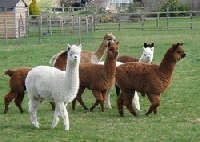Where does alpaca wool come from?
By Catalogs Editorial Staff

Alpaca wool and the animal it comes from
If you ever wondered where does alpaca wool come from, well you might be quite surprised. It comes from an animal that is actually related to the camel. Alpacas can be found in the Altiplano region of South America, an area which reaches over 12,000 ft in height.
Alpacas are very similar to their South American cousins, the llama. They are generally smaller and kept more for their fleece (and meat) whereas llamas are often utilized as pack animals. Like camels, both of these animals are part of the Camelidae family, which also includes guanacos and vicu?as.
There are two types of alpaca; there is the huacaya alpaca and there is the suri alpaca. The huacaya has a fleece with strands that stick out vertically which gives it a “fuzzy” huggable look. The suri’s fleece hangs down which makes it slightly resemble a sheep.
Alpaca Fact
Alpaca’s wool is much prized due to its quality. Because the fibers have fewer scales on them than sheep wool, this means that the fibers are even softer. Suri alpaca wool is softer than huacaya alpaca.
Alpaca Wool Uses
Of course, having such soft luxuriant fibers in its fleece means the alpaca is utilized in the clothing industry. The intrinsic qualities of the fleece also boost its value; for instance, the presence of only a small amount of lanolin (a wax that woolen animals secrete to keep their fleeces water-proof) is believed to contribute to its hypoallergenic properties. This gives clothing manufacturers a handy unique selling point when it comes to alpaca wool.
Sweaters, scarves and alpaca socks are just a few of the clothing items that can be made with the soft alpaca wool. Once the animal has been sheered, the fibers are processed. Alpaca fiber processing involves scouring and spinning – which prepares the fiber for its final purpose. You can find alpaca wool in products such as items of baby clothing, bedding, hats, gloves and even stuffed animals!
~
Home-grown Alpaca Wool
You can actually purchase alpacas as pets! However, before you start buying food and water bowls for your future pet, be warned. They are not going to replace cats or dogs as the domesticated pet of choice. Firstly, you would need to have a lot of outdoor space to keep your alpacas in; they are not going to be happy roaming around a small lawn! Secondly, they are herd animals and reputable breeders would likely recommend they were purchased in groups of at least three.
But if you are determined to spin your own alpaca wool then try to remember that although they are reasonably docile animals, they can kick hard! Tempting them with food will encourage a friendly nature but as they are naturally shy animals they are more likely to run away.
Alpacas are sheered in a similar manner to sheep, although it is recommended they are sheared on their sides (whereas sheep are sheared sitting on their behinds). A handler will keep the animal in position whilst a shearer will remove the animal’s fleece in a painless manner.
Another Alpaca Fact
Alpacas need to be sheered on an annual basis, otherwise overgrown fleeces can cause problems for the animal.
Alpacas Worldwide
So knowing where alpaca comes from, does that mean all the fleeces are exported from the Altiplano of southern Peru, Bolivia, northern Chile and northern Argentina? No, because the great thing about alpacas is their sturdy constitutions, so they have managed to thrive in foreign locations. Alpacas can be found in the USA, Europe and even as far away as New Zealand. However, Peru still has by far the largest population of alpacas (estimated at approximately 90% of the world’s population) and its animals are considered to have the finest fleeces.
Popular Savings Offers











